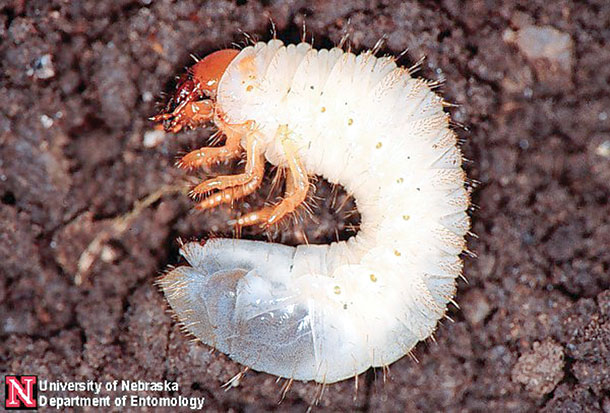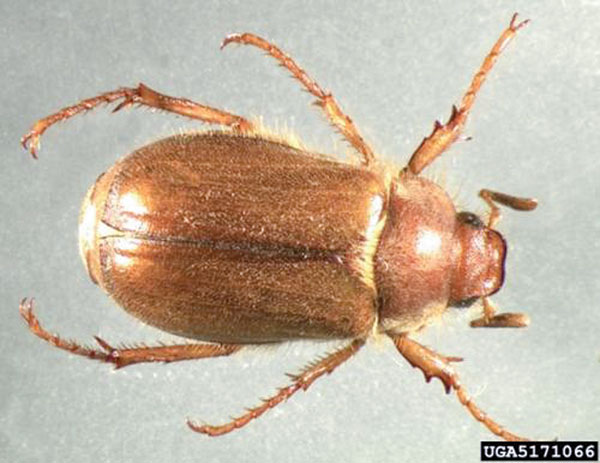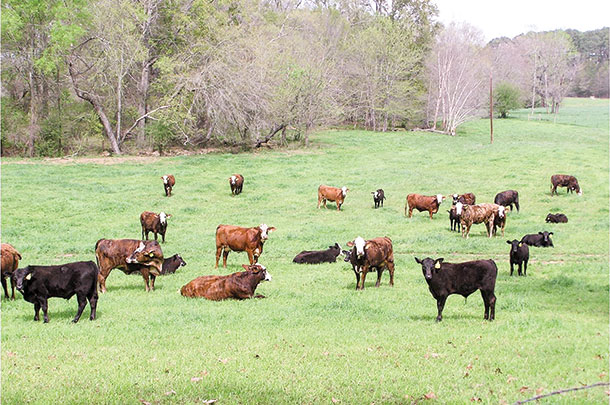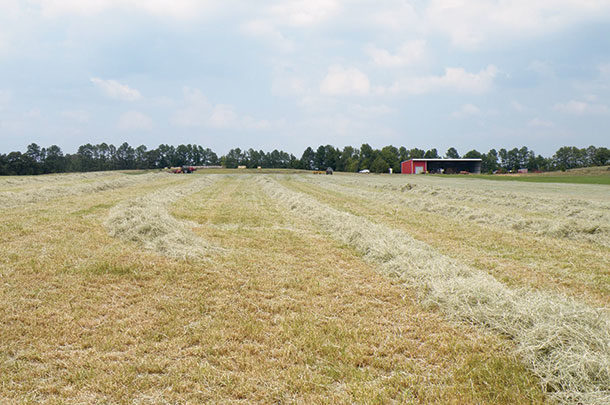Other crops economically affected by grubs are grass hay, maize, sorghum, rice, sugar beets, beans, potato, tomato, coffee, oats, wheat, barley, jasmine, red pine seedlings and tea. The insect is commonly referred to as the white grub.
Grubs are found worldwide but are a particular problem in North, Central and South America. In the U.S., grub species vary among states and are often found in only portions of a state; therefore, information presented in this article will not apply to every area.
County NRCS representatives and agricultural extension agents can provide updates on grub situations in local areas.
“Four types of grubs are common in Alabama grass pastures and hayfields,” says Kathy Flanders, extension entomologist professor at Auburn University. “They are larval stages of green June beetles (Junebugs), May beetles, southern masked chafers and Japanese beetles. Other species of grubs have also caused damage to pasture grasses, but to a lesser extent.”
Where grubs occur
“Reports of green June beetle grub presence mostly comes from producers with pastures having a history of organic fertilizer applications such as chicken litter, manure and sludge,” says Stephen Bambara, extension specialist emeritus, North Carolina State University.
“Seeing grubs in a pasture does not automatically mean a problem, but their identification is important for understanding their life cycle. Often, more than one grub species is present at the same time.”
“Most grub species cause damage by feeding on grass roots, resulting in brown dead patches in pastures and other grasslands,” says Anitha Chirumamilla, extension entomologist, University of Illinois.
“Presence of grubs in damaged spots can be verified by digging about 1 foot deep in a square-foot area and sifting the soil. Generally, five or more grubs per square foot are considered a fairly dense population.”
“Grubs usually infest pasture areas where shallow-rooted non-native cool-season grasses such as smooth bromegrass, Kentucky bluegrass, downy brome or cheatgrass have established,” Chirumamilla says.
“These areas also tend to be moist and are not at extremes of being too wet or too dry. Most producers report infestations in moist but well-drained lowlands or on the sides of slopes where moisture conditions are not at the extremes."
"Rarely do grubs significantly impact areas of healthy native vegetation with deeper, more robust root systems. Some land managers have reported that infestations are heavier within a quarter- to half-mile of trees or shelterbelts where adult beetles generally congregate for breeding.”
“Green June beetle grubs rarely feed on grass roots, but their extensive burrowing activities disrupt root/soil contact,” Flanders says.
“Once soil around roots is loosened, grazing cattle can easily dislodge the plants. When green June beetle grubs are present, the pasture will appear thinned. There will be areas where soil is pulverized, and you may see half-inch-diameter tunnels made by the grubs. Tunneling and pulverizing occurs as grubs feed on organic matter.”
How to recognize the different species
“The green June beetle grub is stout, has short legs, and crawls on its back,” Flanders says. “Green June beetles have one generation per year. The green-and-gold adults fly in the daytime and are a familiar sight in July and August. Eggs hatch in August and early September. Larvae grow to a length of 2 inches by late fall or early spring. Green June beetles have a one-year life cycle.”
“Japanese beetle grubs hatch in mid- to late summer and feed through fall, then move lower in the soil as winter temperatures drop,” Bambara says. “Grubs move back toward the soil surface in the spring and feed on organic matter and root hairs."
"Too much root feeding can cause problems with water and mineral uptake, especially when plants are drought-stressed and when they are young. When feeding is completed, grubs pupate, and adults emerge in early summer. Egg-laying follows shortly after they complete the one-year life cycle.”

“Larvae of May beetles are known as true white grubs,” Chirumamilla says. “May beetle grubs, as well as Japanese beetle grubs and southern masked chafer, curl into a ‘C’ shape when unearthed. Larvae of the May beetle have a ‘zipper’ pattern of hairs (two parallel rows) on the underside of their posterior end. Adults are shiny reddish brown in color and are attracted to lights. The May beetle has up to a three-year life cycle.”

“European chafer grubs are similar in appearance to Japanese beetle grubs,” Bambara says. “Adults tend to be more plainly colored than other grub beetles. They are typically not as abundant nor considered as damaging as Japanese beetle grubs. Their life cycle is completed in one year.”
Southern masked chafers are found primarily in the Southern states, whereas European chafers are predominantly in the Northeast. The two beetles and their larvae are similar in appearance.
Grub management
“Grub management (other than green June beetle grubs) in pastures is difficult as there are no proven effective insecticides that can kill those that burrow deep into the soil,” Chirumamilla says. “Prevention is the best strategy in managing grub issues in pastures. Once damage to grassland is apparent, it is often too late for preventative measures, as damage is essentially done.”
 Chirumamilla says, “On rangeland, cultural practices such as maintaining a healthy pasture with a good balance of native grasses and broadleaf plants and controlling cool-season grasses through grazing rotations are logical steps toward reducing potential infestations."
Chirumamilla says, “On rangeland, cultural practices such as maintaining a healthy pasture with a good balance of native grasses and broadleaf plants and controlling cool-season grasses through grazing rotations are logical steps toward reducing potential infestations."
"In areas where non-native cool-season grasses persist and have shown a tendency to attract grubs, increased grazing intensity in the fall may be beneficial. Heavy grazing will decrease potential for a layer of grass duff to insulate the soil, which will allow the soil to freeze at a greater depth."
"Several producers have observed an increase in grub activity where grasses were allowed to form a mat and where freezing depths were shallow. In hayfields, mixing perennial legumes such as alfalfa with grasses is suggested.”
“Since green June beetle grubs come to the surface, applications of carbaryl (example: Sevin) has activity on this species,” Bambara says. “Expense of chemical treatment may be hard to justify, but if needed, Sevin is most effective in a September application."
"Timing may vary, so treat infested areas based on scouting results. Use an adequate amount of water in the spray mix and observe the 14-day grazing interval noted on the product label. The best time of day to treat is in late afternoon when temperatures are above 70ºF.”
“Pyrethroid insecticides may also control green June beetle grubs,” Flanders says.
“Generally, it is best to allow grubs to complete their life cycle,” Chirumamilla says. “Producers express concern regarding the perceived damage that animals such as raccoons, skunks or badgers may cause to the pasture as they forage for grubs."
"The grubs are the true source of damage, and any negative impacts of foraging animals are often at a shallow depth as they search for grubs under dead sod. Natural predators such as birds, rodents and other small mammals help by digging the grubs. Allowing these animals to forage can help manage grub populations at reasonable levels.”
“There is very little available data that indicates expected levels of replanting success in native rangeland,” Chirumamilla says. If replanting is undertaken, take into account the following basic grassland management principles:
- Use native warm- or cool-season species and avoid exotic cool-season grasses.
- Plant a variety of native grasses and forbs.
- Avoid intensive management of establishment areas that could drive the system back to a less desired plant community.
- Avoid non-native legumes in native pasture settings.
- Ensure good seed-to-soil contact in a firm seed bed without planting too deep. In grasslands or hayfields, establishing additional diversity of native plants or use of legumes could help curb a continual grub problem.
Chirumamilla says, “Regardless of the recovery plan, it is not recommended that landowners till native pasture soils in an attempt to control grubs because the long-term impacts of this land conversion may be much more damaging than the short-term impacts of the grubs.”
Several states are reporting increased grub activity in pastures.
If you use organic fertilizer or have other environmental conditions that attract grubs, you should consider the use of preventive management practices. FG
Robert Fears is a freelance writer based in Texas.
PHOTO 1: Grubs can be a problem in hayfields, as well as in range or pastures. Photo courtesy of Monte Rouquette, Texas A&M AgriLife Research.
PHOTO 2: A white grub larva curls into the characteristic “C” shape, giving it the common name of ‘white grub.’ Photos courtesy of University of Nebraska Department of Entomology
PHOTO 3: A European chafer adult grub has a one-year life cycle. Photo courtesy of University of Georgia.
PHOTO 4: rub infestation can be prevented through grazing management. Photo courtesy of Monte Rouquette, Texas A&M AgriLife Research.









